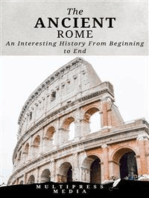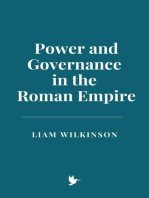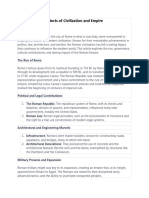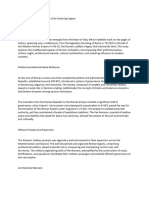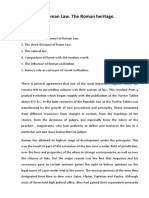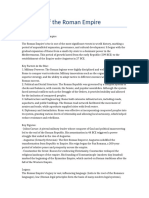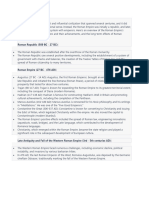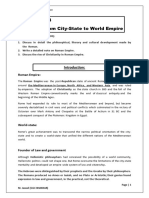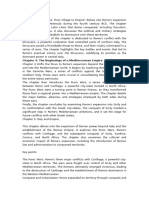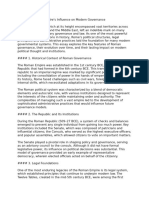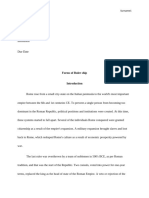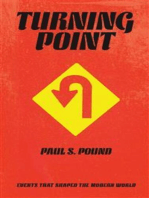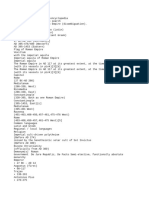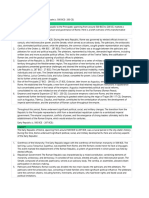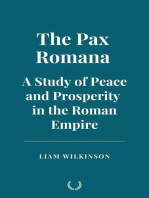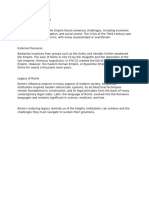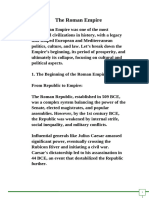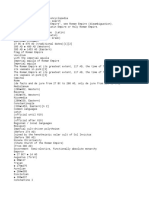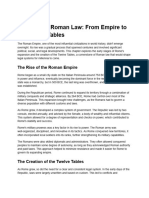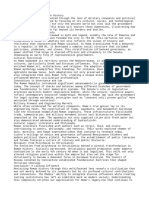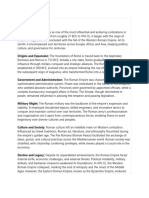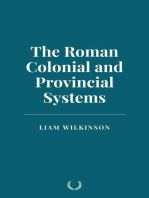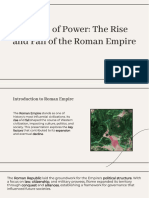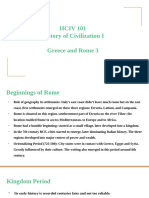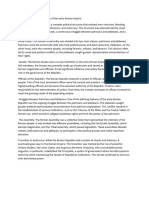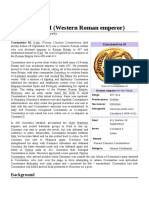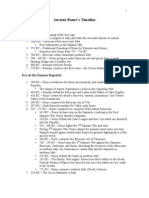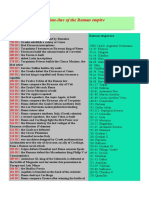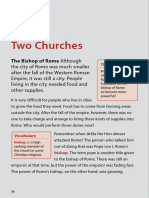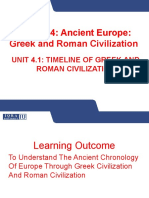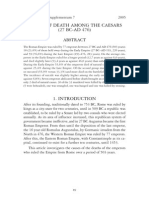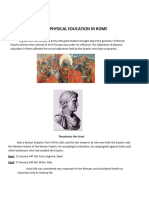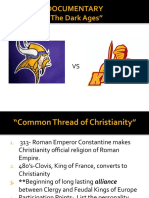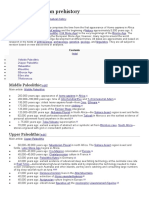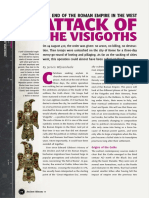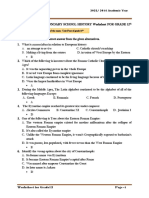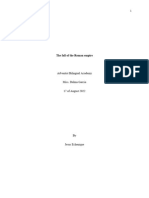0 ratings0% found this document useful (0 votes)
19 viewsDossier Salma Ilham Imane
Dossier Salma Ilham Imane
Uploaded by
hajaroufkir64The Roman Empire rose to power through territorial conquests and civil wars during the Roman Republic period. After Augustus Caesar consolidated power in 44 BC, the Roman Empire reached its peak under Trajan in the 2nd century AD. However, internal challenges and external threats led to the division and eventual fall of the Western Roman Empire in 476 AD. The Roman Empire established a complex political and social system that brought both strengths like stability and weaknesses like inequality. Its lasting legacy continues to influence modern civilization through aspects like representative government, equality before the law, engineering innovations, and the Latin-derived Romance languages still spoken today.
Copyright:
© All Rights Reserved
Available Formats
Download as DOCX, PDF, TXT or read online from Scribd
Dossier Salma Ilham Imane
Dossier Salma Ilham Imane
Uploaded by
hajaroufkir640 ratings0% found this document useful (0 votes)
19 views3 pagesThe Roman Empire rose to power through territorial conquests and civil wars during the Roman Republic period. After Augustus Caesar consolidated power in 44 BC, the Roman Empire reached its peak under Trajan in the 2nd century AD. However, internal challenges and external threats led to the division and eventual fall of the Western Roman Empire in 476 AD. The Roman Empire established a complex political and social system that brought both strengths like stability and weaknesses like inequality. Its lasting legacy continues to influence modern civilization through aspects like representative government, equality before the law, engineering innovations, and the Latin-derived Romance languages still spoken today.
Original Title
dossier salma ilham imane
Copyright
© © All Rights Reserved
Available Formats
DOCX, PDF, TXT or read online from Scribd
Share this document
Did you find this document useful?
Is this content inappropriate?
The Roman Empire rose to power through territorial conquests and civil wars during the Roman Republic period. After Augustus Caesar consolidated power in 44 BC, the Roman Empire reached its peak under Trajan in the 2nd century AD. However, internal challenges and external threats led to the division and eventual fall of the Western Roman Empire in 476 AD. The Roman Empire established a complex political and social system that brought both strengths like stability and weaknesses like inequality. Its lasting legacy continues to influence modern civilization through aspects like representative government, equality before the law, engineering innovations, and the Latin-derived Romance languages still spoken today.
Copyright:
© All Rights Reserved
Available Formats
Download as DOCX, PDF, TXT or read online from Scribd
Download as docx, pdf, or txt
0 ratings0% found this document useful (0 votes)
19 views3 pagesDossier Salma Ilham Imane
Dossier Salma Ilham Imane
Uploaded by
hajaroufkir64The Roman Empire rose to power through territorial conquests and civil wars during the Roman Republic period. After Augustus Caesar consolidated power in 44 BC, the Roman Empire reached its peak under Trajan in the 2nd century AD. However, internal challenges and external threats led to the division and eventual fall of the Western Roman Empire in 476 AD. The Roman Empire established a complex political and social system that brought both strengths like stability and weaknesses like inequality. Its lasting legacy continues to influence modern civilization through aspects like representative government, equality before the law, engineering innovations, and the Latin-derived Romance languages still spoken today.
Copyright:
© All Rights Reserved
Available Formats
Download as DOCX, PDF, TXT or read online from Scribd
Download as docx, pdf, or txt
You are on page 1of 3
Roman Empire
The Rise and Fall of the Roman Empire
The history of the Roman Empire is divided into several significant periods. The period of
the Roman Republic was marked by territorial conquests, civil wars and the emergence
of leaders such as Julius Caesar. After Caesar's assassination in 44 BC, Octavian Augustus
consolidated power and established the Empire.
Rome underwent significant territorial expansion, reaching its geographical peak under
Trajan in the early 2nd century. The emperors also adopted important policies, such as
the Pax Romana, a period of relative peace that fostered economic and cultural stability.
However, in the 3rd century, the Roman Empire began to face internal challenges, such
as power struggles, economic crisis, and external threats, including invasions by
Germanic tribes and pressure from the Persians.
In the 4th century, the Roman Empire was divided into two independent parts, the
Western Roman Empire and the Eastern Roman Empire (or Byzantine Empire). In 476
AD, the Western Roman Empire finally fell to barbarian invasions, symbolized by the
deposition of the last Roman emperor, Romulus Augustulus, marking the end of
Antiquity and the beginning of the Middle Ages in Europe.
The political and social system of the Roman Empire
The Roman Empire, which spanned several centuries, inherited a complex political and
social system. Politically, it evolved from a Republic into an Empire ruled by an Emperor.
The political system of the Roman Empire had some notable strengths. Initially a
Republic, it was characterized by a representative government where citizens had a
voice in political decisions. However, as the Empire evolved into an imperial monarchy,
political stability became a major strength. Emperors, though sometimes authoritarian,
brought political unity to a vast territory. However, this centralization of power also
engendered weakness, with risks of tyranny and poor governance. What's more, the
transition from Republic to Empire gave rise to internal political struggles, marked by
conspiracies and civil wars, revealing the intrinsic fragility of the Roman political system.
In social terms, ancient Rome developed a class system with an influential aristocracy.
The social system of the Roman Empire had significant strengths. The establishment of a
social hierarchy with an aristocracy offered a degree of stability, while Roman
citizenship brought rights and benefits to certain individuals. This encouraged a degree
of social mobility, where talented individuals could rise to influential positions.
However, this mobility was often limited, and much of society was made up of slaves
and non-citizens, resulting in marked inequalities. In addition, periods of economic
turmoil and social revolt reflected the weaknesses of the system, contributing to
internal tensions and leading, in part, to the subsequent decline of the Roman Empire.
The Lasting Legacy of the Roman Empire
The legacy of the ancient Romans has had a considerable influence on subsequent
cultures, and continues to be felt in modern civilization throughout the world. Roman
inventions or innovations were so effective that they persisted throughout history and
were later rediscovered to serve as models for virtually every aspect of human society,
from the most mundane to the most sublime. These aspects include, but are not limited
to:
Governments : The influence of the Roman Republic on government continued,
contributing to the conceptualization of democracy and the creation of representative
political systems. The separation of powers - executive, legislative, judicial - and ideas of
citizenship have endured, contributing to the creation of modern institutions, notably in
the United States, where the Roman political model inspired the establishment of a
democratic republican governmental structure. Thus, the Roman legacy has left a deep
imprint on contemporary governance.
Law: The concept of equality before the law, regardless of social class, is a major Roman
innovation, as are trial by jury, civil rights, personal wills and commercial companies.
The Twelve Tables, addressing the specifics of the law and sanctions, laid the
foundations for these principles. This Roman legal model, combined with Roman
government, profoundly influenced the founding fathers of the United States of
America. Thus, Roman influence on the conception of equality before the law and
governmental structure continues to overcome the centuries, shaping modern
civilization throughout the world.
Technology and engineering: The Romans made a major contribution to architecture
with their intelligent use of concrete, arches and domes. Their roads and aqueducts
bear witness to their expertise, influencing construction for centuries. Even today,
structures such as the U.S. Capitol are inspired by their know-how.
Language: Latin, spoken by the Romans, influenced Romance languages such as French,
Italian and Spanish. Many Latin words, such as "school" (schola) and "island" (insula),
form the basis of modern English. Latin expressions such as "carpe diem" continue to be
familiar, illustrating the lasting influence of Latin on modern civilization.
Military organization: The Roman army, though not the first, was the best of its time.
The Romans introduced military ideas still used today, such as compulsory training and
the possibility for any soldier to progress. Their way of organizing the army with
engineers, logisticians and efficient medical care also had a great influence. This
influence is reflected in the increased survival of soldiers compared to other historical
periods, such as the American Civil War of the 19th century.
You might also like
- The Rise of The Roman EmpireDocument2 pagesThe Rise of The Roman Empiredaniel holmesNo ratings yet
- A Brief History of RomeDocument20 pagesA Brief History of RomeNevenka Mandragora AtanasoskaNo ratings yet
- ESO 2 Essential Geography and History Unit 1Document17 pagesESO 2 Essential Geography and History Unit 1Nataliasol07No ratings yet
- The Roman EmpireDocument4 pagesThe Roman EmpiresyedashahworkNo ratings yet
- Roman Empire World History ManuscriptDocument15 pagesRoman Empire World History ManuscriptZyra VicendarioNo ratings yet
- PDF 5Document2 pagesPDF 5BorisNo ratings yet
- The Roman Empire A Tale of Power, Innovation, and LegacyDocument2 pagesThe Roman Empire A Tale of Power, Innovation, and LegacyStancu AlexNo ratings yet
- Roman EmpireDocument2 pagesRoman Empirehoxeme1720No ratings yet
- The Ancient Rome: An Interesting History From Beginning to EndFrom EverandThe Ancient Rome: An Interesting History From Beginning to EndNo ratings yet
- RomansDocument2 pagesRomanswaiNo ratings yet
- Roman 8Document4 pagesRoman 8Irfanullah ChhajroNo ratings yet
- TheromanempireDocument1 pageTheromanempireMuhammad HafiyNo ratings yet
- The RomansDocument2 pagesThe Romansizzybrooker1No ratings yet
- Roman Law. The Roman Heritage.Document9 pagesRoman Law. The Roman Heritage.Nəzrin HüseynovaNo ratings yet
- The Roman EmpireDocument36 pagesThe Roman Empirethiago2.0tecnoNo ratings yet
- Roman Republic DissertationDocument6 pagesRoman Republic DissertationBuyPaperOnlineSingapore100% (1)
- Rome Republic, Principate and EmpireDocument21 pagesRome Republic, Principate and EmpireHimanshu GusainNo ratings yet
- The Rise of The Roman Empire UpdatedDocument2 pagesThe Rise of The Roman Empire UpdatedFall OutNo ratings yet
- Procedures and Practicals of A Solo Mind HeadDocument9 pagesProcedures and Practicals of A Solo Mind HeadmNo ratings yet
- Chapter 4 The RomanDocument14 pagesChapter 4 The Romanbc190405823No ratings yet
- History NotesDocument4 pagesHistory NotesQueen BreaNo ratings yet
- Class note about Roman empireDocument16 pagesClass note about Roman empirerrr094288No ratings yet
- Asfarah 2023ba002 Week 3,4,5,6,7Document3 pagesAsfarah 2023ba002 Week 3,4,5,6,7Asfarah MaishaNo ratings yet
- The Fall of The Roman EmpireDocument4 pagesThe Fall of The Roman EmpireElijah100% (1)
- The Roman EmpireDocument3 pagesThe Roman Empiretoystest112No ratings yet
- RomanDocument2 pagesRomanrosiro8536No ratings yet
- Forms of RulershipDocument4 pagesForms of RulershipChris ochiengNo ratings yet
- Rome EmpireDocument70 pagesRome EmpireTania SmithNo ratings yet
- Rome From The Republic To PrincipateDocument6 pagesRome From The Republic To Principatepdanger497No ratings yet
- The Pax Romana: A Study of Peace and Prosperity in the Roman EmpireFrom EverandThe Pax Romana: A Study of Peace and Prosperity in the Roman EmpireNo ratings yet
- The Origin of State: The Evolutionary TheoryDocument3 pagesThe Origin of State: The Evolutionary TheoryMd. Mashfiq Rizvee 1811173642No ratings yet
- History of The Roman EmpireDocument120 pagesHistory of The Roman EmpireGeorgeNo ratings yet
- RomeDocument1 pageRomeZayn AhmedNo ratings yet
- Sofo E-Content Crisis of Roman Empire - I Unit I 03.04.2020Document6 pagesSofo E-Content Crisis of Roman Empire - I Unit I 03.04.2020Aryabhatta CollegeNo ratings yet
- The Roman EmpireDocument10 pagesThe Roman Empirehabibaamahmed453No ratings yet
- The Rise and Fall of The Roman EmpireDocument8 pagesThe Rise and Fall of The Roman Empirehaniafaraz2013No ratings yet
- Home Egypt Middle Ages Greece Rome Asia China AmericanDocument5 pagesHome Egypt Middle Ages Greece Rome Asia China AmericanshaiNo ratings yet
- ANCIENT ROMAN CIVILIZATION Study ExamDocument11 pagesANCIENT ROMAN CIVILIZATION Study Exammelissacephas25No ratings yet
- 65ramon EmpireDocument25 pages65ramon EmpireFernando RamirezNo ratings yet
- A Review Essay of Escape From RomeDocument27 pagesA Review Essay of Escape From RomemarvinmartesNo ratings yet
- The Birth of Roman Law From Empire To The Twelve TablesDocument2 pagesThe Birth of Roman Law From Empire To The Twelve TablessainzruizmmNo ratings yet
- Roman EmpireDocument4 pagesRoman EmpireKiran AsifNo ratings yet
- RomansDocument2 pagesRomansharshwilldoitNo ratings yet
- Leandro Rafael Guzm N Dom Nguez - 2395700 - Assignsubmission - File - Semana 2 Derecho RomanoDocument13 pagesLeandro Rafael Guzm N Dom Nguez - 2395700 - Assignsubmission - File - Semana 2 Derecho RomanoMartha ToribioNo ratings yet
- Eastern Rome and The WestDocument10 pagesEastern Rome and The WestNəzrin HüseynovaNo ratings yet
- Roman EmpireDocument2 pagesRoman EmpirePaul BagabaldoNo ratings yet
- CHP 6 Section 1Document5 pagesCHP 6 Section 1api-233607134No ratings yet
- Ancient RomeDocument2 pagesAncient RomeYousra BensekhriaNo ratings yet
- Origins of The Roman EmpireDocument3 pagesOrigins of The Roman EmpireNaveen KumarNo ratings yet
- History of RomeDocument1 pageHistory of Romenabongdylan48No ratings yet
- Kami Export - Revision 4Document2 pagesKami Export - Revision 430-4110No ratings yet
- Roman Constitutional HistoryDocument17 pagesRoman Constitutional HistoryNaomi VimbaiNo ratings yet
- Slidesgo Echoes of Power The Rise and Fall of The Roman Empire 20241111174156LKlKDocument8 pagesSlidesgo Echoes of Power The Rise and Fall of The Roman Empire 20241111174156LKlKoctavianantonasNo ratings yet
- Greece and Rome 3Document14 pagesGreece and Rome 3gulsima666No ratings yet
- Roman Republic Thesis TopicsDocument8 pagesRoman Republic Thesis Topicsewdgbnief100% (2)
- Explain The Political Structure of The Early Roman EmpireDocument2 pagesExplain The Political Structure of The Early Roman Empireswetha mahendramaniNo ratings yet
- Origins of The Roman EmpireDocument3 pagesOrigins of The Roman EmpireNaveen KumarNo ratings yet
- Rome - Republic To EmpireDocument31 pagesRome - Republic To EmpirealaminNo ratings yet
- Constantine III (Western Roman Emperor)Document10 pagesConstantine III (Western Roman Emperor)oksvb26No ratings yet
- Ancient Rome's TimelineDocument6 pagesAncient Rome's TimelineGüven Sevencan100% (1)
- Ancient RomeDocument65 pagesAncient Romeapi-443568616No ratings yet
- Roman Empire TimelineDocument8 pagesRoman Empire TimelineprominusNo ratings yet
- Attila The Ruler of The Huns ArticleDocument9 pagesAttila The Ruler of The Huns ArticleMoises CandiaNo ratings yet
- QuestionsDocument8 pagesQuestionspjor2932No ratings yet
- Unit 4 - WHDocument60 pagesUnit 4 - WHZain khanNo ratings yet
- Barbarian Invasions of The Roman EmpireDocument2 pagesBarbarian Invasions of The Roman EmpirewillubeminetoNo ratings yet
- Roman EmpireDocument6 pagesRoman EmpireROUIDJI YoucefNo ratings yet
- Causes of Death Among The CaesarsDocument18 pagesCauses of Death Among The CaesarsJerry WatkinsNo ratings yet
- The Physical Education in RomeDocument4 pagesThe Physical Education in Romeunis magoNo ratings yet
- Geo Unit 8 RomeDocument10 pagesGeo Unit 8 RometalaNo ratings yet
- Concepts RomeDocument5 pagesConcepts RomeAnna KostovaNo ratings yet
- The Dark Ages FilmDocument13 pagesThe Dark Ages FilmfinkcastleNo ratings yet
- The Early Middle Ages The Germanic Kingdoms: The Carolingian EmpireDocument12 pagesThe Early Middle Ages The Germanic Kingdoms: The Carolingian Empireviknesh thilakNo ratings yet
- Timeline of Human PrehistoryDocument32 pagesTimeline of Human PrehistoryLucas Lobo100% (1)
- Visigoths and The End of Rome PDFDocument8 pagesVisigoths and The End of Rome PDFJemarturNo ratings yet
- Roman Empire - Across 3 Continents Class XIDocument61 pagesRoman Empire - Across 3 Continents Class XINooneNo ratings yet
- Fall of Rome ReadingDocument4 pagesFall of Rome ReadingRajkumar SahuNo ratings yet
- Church History QuizzesDocument61 pagesChurch History QuizzesScribdTranslationsNo ratings yet
- U-4 of 11th WorksheetDocument4 pagesU-4 of 11th WorksheetBiftu ShibbireNo ratings yet
- The Fall of The Roman EmpireDocument4 pagesThe Fall of The Roman EmpireJesus EcheniqueNo ratings yet
- Universal History Vol IDocument538 pagesUniversal History Vol IŽarkoMarinković100% (1)
- The Great Schism The History and Legacy of The Split Between The Catholic and Eastern Orthodox Churches in 1054 (Charles River Editors) (Z-Library)Document76 pagesThe Great Schism The History and Legacy of The Split Between The Catholic and Eastern Orthodox Churches in 1054 (Charles River Editors) (Z-Library)awidjawariNo ratings yet
- A Guide To Roman BulgariaDocument24 pagesA Guide To Roman BulgariaМихаил Новак100% (1)
- Charlemagne "Charles The Great" and The Holy Roman Empire: Lesson 11-1Document17 pagesCharlemagne "Charles The Great" and The Holy Roman Empire: Lesson 11-1Janeza Cris CastroNo ratings yet








